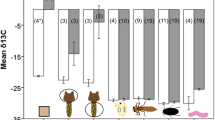Abstract
Rates of organic uptakes of three live diatoms (Nitzschia acicularis, Nitzschia sp. andNavicula incerta), and of three corresponding filtrates by the deposit-feeding polychaeteEupolymnia nebulosa (Montagu) were measured under similar experimental conditions. Worms used during this study were collected by SCUBA diving at Port-Vendres in shallow water (7 m deep) during the summer of 1986. Uptake rates of live diatoms were affected both by length of the experiments and by the nature of the food offered. The highest rate of uptake (11.8 10−4 mg algal ash-free dry wt mg−1 worm dry wt h−1) was recorded during a short-term experiment (4 h) with the smallest diatom (Nitzschia sp.). The lowest rate (1.1 10−4 mg algal ash-free dry wt mg−1 worm dry wt h−1) was recorded during a long-term experiment (48 h) with the largest diatom (Nitzschia acicularis). Filtrates ofN. acicularis were more readily utilized than those ofNitzschia sp. andNavicula incerta. Because of differences in uptake rates of algal filtrates as a function of species, it is not possible to evaluate the bias due to interaction with dissolved substances in experimental studies assessing ingestion of live benthic diatoms byE. nebulosa.
Similar content being viewed by others
Literature cited
Adams, S. M., Angelovic, J. W. (1970). Assimilation of detritus and its associated bacteria by three species of estuarine animals. Chesapeake Sci. 12: 249–254
Amouroux, J. M. (1984). Preliminary study on the consumption of dissolved organic matter (exudates) of bacteria and phytoplankton by the marine bivalveVenus verrucosa. Mar. Biol. 82: 109–112
Amouroux, J. M. (1986a). Comparative study of the carbon cycle inVenus verrucosa fed on bacteria and phytoplankton. I. Consumption of bacteria (Lactobacillus sp.). Mar. Biol. 90: 237–241
Amouroux, J. M. (1986b). Comparative study of the carbon cycle inVenus verrucosa fed on bacteria and phytoplankton. II. Consumption of phytoplankton (Pavlova lutheri). Mar. Biol. 92: 349–354
Amouroux, J. M., Grémare, A., Amouroux, J. (1989). Modelling of consumption and assimilation inAbra alba (Mollusca: Bivalvia). Mar. Ecol. Prog. Ser. 51: 87–97
Bardstate, R. J., Prenki, R. T., Fenchel, T. (1974). Phosphorous cycle of model ecosystem: significance for decomposer food chains and effects of bacteria grazers. Oikos 25: 239–251
Calow, P., Fletcher, C. R. (1972). A new radiotracer technique involving14C and51Cr for estimating the assimilation efficiencies of aquatic, primary consumers. Oecologia 9: 155–170
Cammen, L. M. (1980a). A method for measuring ingestion rate of deposit-feeders and its use with the polychaeteNereis succinea. Estuaries 3: 55–60
Cammen, L. M. (1980b). The significance of microbial carbon in the nutrition of the deposit feeding polychaeteNereis succinea. Mar. Biol. 61: 9–20
Conover, R. J., Francis, V. (1973). The use of radioactive isotopes to measure the transfer of materials in aquatic food chains. Mar. Biol. 18: 272–283
Crosby, M. P. (1985). The use of a rapid radiolabelling method for measuring the ingestion rates of detritivores. J. exp. mar. Biol. Ecol. 93: 273–283
Dring, M. J., Jewson, D. H. (1982). What does14C uptake by phytoplankton really measure? A theoretical approach. Proc. R. Soc. (Ser. B) 214: 351–368
Grémare, A. (1986). A comparative study of the reproductive energetics of two populations of the terebellid polychaeteEupolymnia nebulosa (Montagu) with different reproductive modes. J. exp. mar. Biol. Ecol. 96: 287–302
Grémare, A. (1988a). Feeding, tube-building and particle-size selection in the terebellid polychaeteEupolymnia nebulosa. Mar. Biol. 97: 243–252
Grémare, A. (1988b). Aspects quantitatifs de la reproduction chez quelques annélides poly\({}^\backprime c\)hètes: Intérêt et perspectives. Thèse Doctorat, Université Paris 6
Grémare, A., Amouroux, J. M., Amouroux, J. (1989). Modelling of consumption and assimilation in the deposit-feeding polychaeteEupolymnia nebulosa. Mar. Ecol. Prog. Ser. 54: 239–248
Guidi, L. D. (1986). The feeding response of the epibenthic amphipodSiphonocoetes dellavallei Stebbing to varying particle sizes and concentrations. J. exp. mar. Biol. Ecol. 98: 51–63
Guidi, L. D., Tito de Morais, A. (1983). Ascidian faecal pellets and their utilization by an epibenthic amphipod. J. exp. mar. Biol. Ecol. 71: 289–298
Guilliard, R. R. L., Ryther, J. H. (1962). Studies on marine planktonic diatoms. I.Cyclotella nana Hustedt andDenotula confervaea (Cleve) Gran. Can. J. Microbiol. 8: 229–239
Jensen, L. M. (1983). Phytoplankton release of extracellular organic carbon, molecular weight composition and bacterial assimilation. Mar. Ecol. Prog. Ser. 11: 39–48
Kemp, P. F. (1986). Direct uptake of detrital carbon by the depositfeeding polychaeteEuzonus mucronata (Treadwell). J. exp. mar. Biol. Ecol. 99: 49–61
Kofoed, L. H. (1975). The feeding biology ofHydrobia ventrosa (Montagu). I. The assimilation of different components of the food. J. exp. mar. Biol. Ecol. 19: 233–241
Lopez, G. R., Cheng, I. J. (1983). Synoptic measurements of ingestion rate, ingestion selectivity, and absorption efficiency of natural foods in the deposit-feeding molluscsNucula annulata (Bivalvia) andHydrobia totteni (Gastropoda). Mar. Ecol. Prog. Ser. 11: 55–62
Mague, T. H., Friberg, E., Hughes, J. D., Morris, I. (1980). Extracellular release of carbon of marine phytoplankton: a physiological approach. Limnol. Oceanogr. 25: 262–270
Sepers, A. B. J. (1977). The utilization of dissolved organic compounds in aquatic environment. Hydrobiologia 52: 39–54
Smith, D. F., Horner, M. J. (1981). Tracer kinetic analysis applied to problems in marine biology. Can. Bull. Fish. aquat. Sciences 210: 113–129
Snedecor, G. W., Cochran, W. G. (1980). Statistical methods. 7th ed. Iowa State University Press, Ames, Iowa, USA
Tenore, K. R. (1975). Detrital utilization by the polychaeteCapitella capitata. J. mar. Res. 33: 261–274
Watanabe, Y. (1980). A study of the excretion and extracellular products of natural phytoplankton in lake Nakanuma, Japan. Int. Revue ges. Hydrobiol. 65: 809–834
Wolfinbarger, L., Crosby, M. P. (1983). A convenient procedure for radiolabeling detritus with14C-dimethylsulfate. J. exp. mar. Biol. Ecol. 67: 185–198
Author information
Authors and Affiliations
Additional information
Communicated by J. M. Pérès, Marseille
Rights and permissions
About this article
Cite this article
Grémare, A. Consumption of diatoms and diatom filtrates by the tentaculate deposit-feederEupolymnia nebulosa (Annelida: Polychaeta). Mar. Biol. 106, 139–143 (1990). https://doi.org/10.1007/BF02114684
Accepted:
Issue Date:
DOI: https://doi.org/10.1007/BF02114684




